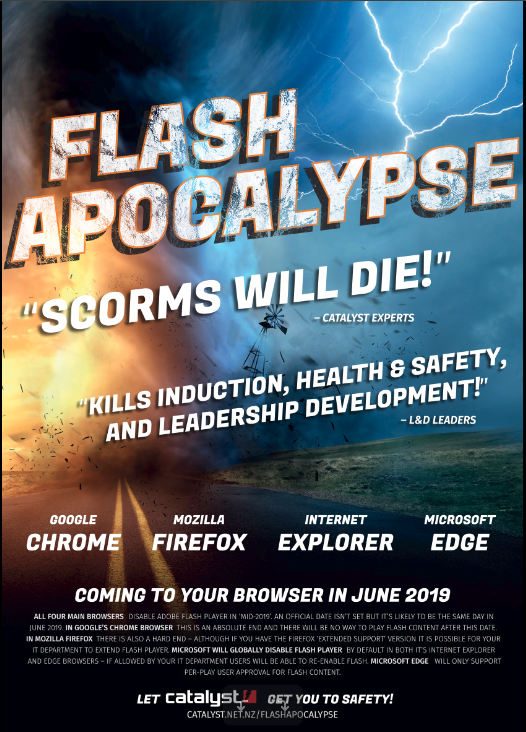Flash is going EOL in 2020 but most browsers will drop support in mid-2019.
Years ago the IT community and popular media got excited about the Y2K bug that was due to plunge us into a digital dark age at midnight on 31 Dec 1999. I was at a party that night and watched over the city lights waiting for the disaster to hit; nothing happened except for one crazy good party. Aside from the whole ordeal getting oversold the reason it wasn’t a big deal is that many had worked hard to fix the issues at their source – the software used (and still used) to power the most important parts of the infrastructure of daily life; including water, power, medical systems, and banking.
The Flash apocalypse is quite different. We’ve known for ages that Flash is a dying technology and frankly it will not be mourned. Two years ago Adobe formally announced it’s end-of-life date of December 2020. What was less noticed, is that each major browser then issued their own timeline for the disabling of the Flash Player.
- Chrome took the strongest stance. It has it’s own built in Flash player and historically led the charge to ‘silence’ Flash playing in other tabs and later to non-visible parts of the current web page. Now, Flash needs to be approved for a site on first visit. They have advised Flash support will end by mid-2019.
- Firefox also has a strong stance, currently Flash is disabled by default and requires approval to run for each site. Again, in mid-2019 they will disable the Flash Player.
- Microsoft’s Edge browser also takes a strong stance. It has it’s own Flash player and requires users to allow Flash content to play. Again, in mid-2019 they will disable the Flash Player.
- Internet Explorer currently has no restrictions on Flash player. It will in mid-2019 disable Flash player plugin. Users will be able to reinstall the Flash plugin. However, I think it’s unlikely to be supported by their IT departments!
The problem, is that IT departments think Flash is history and of those administrating LMS sites we don’t see any evidence of awareness of the amount of Flash in their elearning catalogues. At Catalyst we host a large number of elearning platforms and know that there is a lot of Flash hidden inside SCORM modules in both corporate and academic sites. Without action the full impact of the end of Flash support will be significant – we’re calling it the Flash apocalypse.
Our Flash apocalypse report for Moodle & Totara
We’re so concerned about this, we created, and shared, a new Moodle/Totara report that finds the Flash in your site. It’s even clever enough to spot false positives for SCORM modules that have been ‘dual published’ with both Flash and its replacement HTML5 versions. You should see Dan’s blog post describing the report and how to get it.
We are starting to see some real world examples of the Flash apocalypse
A corporate client who originally advised that they only had a couple of old courses with Flash installed our report and were very surprised to find 430 of their live courses dependant on Flash. They are still triaging this but could be looking at trying to replace all 430 courses in six months – an average of 71 per month and sustained over six months. This isn’t great and will impact and delay their core programme of work.
However, they will avoid the alternative, a catalogue of unplayable elearning content.
What should you do?
The first step is to get informed, and then determine your site’s exposure to Flash. Our report is available in the Moodle Plugin directory and Totara vendors can install this on Totara sites. Contact us if you need a hand.
We have a Flash apocalypse poster designed to be shared around learning & development professionals so you can help prepare your colleagues.
When building replacement courses do use the free LMS native tools and also consider the open source H5P plugin. It’ll help avoid another content apocalypse in a few years time. Again, contact us if you need a hand.
Together, we can help avoid the flash apocalypse.

